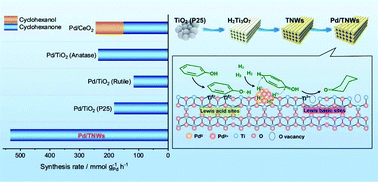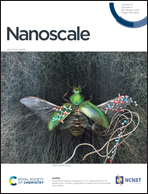Photodeposition of Pd onto TiO2 nanowires for aqueous-phase selective hydrogenation of phenolics to cyclohexanones†
Abstract
The selective hydrogenation of phenolics to cyclohexanones is an important process in both industrial application and utilization of fossil and renewable feedstocks. However this process remains a challenge in achieving high conversion of phenolics and high selectivity of ketones under mild reaction conditions. In this work, TiO2 nanowires (TNWs) are successfully synthesized by using an integrated method and the ultra-small Pd clusters were then deposited onto the TNWs by photoreduction. The obtained Pd/TNW catalyst shows superior catalytic performances in the hydrogenation of phenolic derivatives to the corresponding cyclohexanones. In particular, a nearly full conversion of phenol with high selectivity (>99.0%) to cyclohexanone can be achieved at 50 °C and 5.0 bar H2 in water. A series of characterization studies by means of XRD, XPS, EPR, FTIR, TPD, STEM, and kinetic studies indicate that abundant exposed Lewis acid and basic sites on the surface of TNWs play important roles in the activation of phenolics and desorption of cyclohexanones, while the Pd clusters by photodeposition can attain a hybrid of Pd0 and Pd2+ species to facilitate the activation of dihydrogenation. A plausible catalytic pathway with synergistic effects of TNWs and Pd species is then proposed.



 Please wait while we load your content...
Please wait while we load your content...